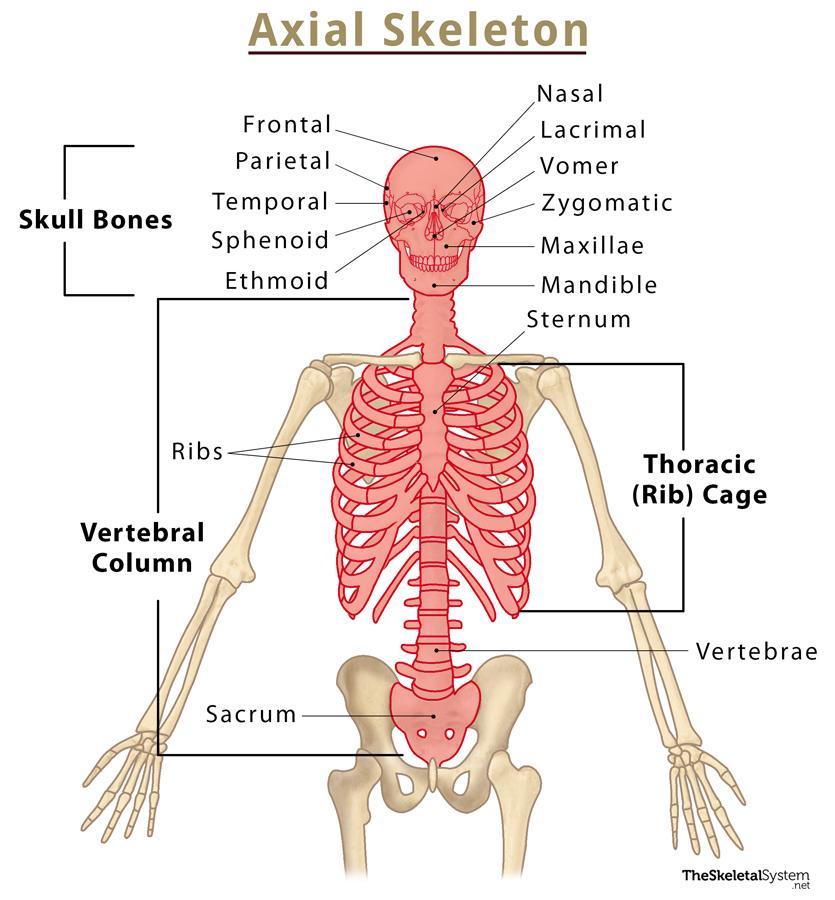Axial Skeleton
What is the Axial Skeleton
The human skeleton is divided into two parts, with the axial skeleton being one of the two. The other one is the appendicular skeleton. There are 80 bones in the axial skeleton. As the name suggests, it includes the bones from the body’s vertical axis.
Basic Functions of the Bones in the Axial Skeleton
Their functions contain protecting and supporting vital organs and systems like the brain, spinal cord, heart, and lungs. The bones also provide a point of attachment for all the muscles and ligaments that allow us to move our neck and back.
The axial skeleton also stabilizes and helps with the functioning of the appendicular skeleton bones.
Parts of the Axial Skeleton With Names of Bones
The axial skeleton bones are located one after the other to form the long axis of the body, and given below are their names in order from head to lower back
Skull Bones
There are 22 bones in the skull, divided into two groups:
Cranial Bones
These bones together form the braincase where the brain is located. There are 8 cranial bones:
- Frontal bone (1)
- Occipital bone (1)
- Parietal bones (2)
- Sphenoid bone (1)
- Ethmoid bone (1)
- Temporal bones (2)
Facial Bones
As the name suggests, these are the bones of the face:
- Maxillae/upper jaw bones (2)
- Lacrimal bone (2)
- Zygomatic bone/cheekbones (2)
- Palatine bone (2)
- Nasal bones (2)
- Inferior nasal concha (2)
- Vomer (1)
- Mandible (1)
The horseshoe-shaped bone at the front of the neck is called the hyoid bone. It is counted in the skull bones, but is not included in the cranial or facial bones. It is essential to speech and more because it supports the tongue.
Auditory Ossicles
These are three tiny bones in the middle ear region that help carry sound vibrations from the outer ear through the middle ear into the inner ear so they can be carried to the brain as electrical impulses, allowing us to hear.
These are the smallest bones in the body, named:
Vertebral Column
The human vertebral or spinal column comprises 24 irregular bones called vertebrae stacked on top of each other, as well as the fused bones sacrum and coccyx. The primary function of the vertebral column is to protect the spinal cord and allow it passage down the body from the skull.
The first 24 bones are divided into 3 sections, followed by the fuse bones:
- Cervical vertebrae (7)
- Thoracic vertebrae (12)
- Lumbar vertebrae (5)
- Sacrum (5 fused)
- Coccyx/tailbone (4 fused)
Thoracic (Rib) Cage
The rib cage is an essential bony formation that create a protective casing for organs like the lungs and heart. It is also where the muscles of respiration attach, helping the rib cage perform the respiratory movements. It consists of the following bones:
- Sternum/breastbone (1)
- Ribs (24)
References
- Axial Skeleton – Clevelandclinic.org
- Human Axial Skeleton – Courses.lumenlearning.com
- Along the Axis of the Axial Skeleton: Bones That Form the Axial Skeleton – Visiblebody.com
- The Axial Skeleton – Med.libretexts.org
- Axial Skeleton (80 bones) – Training.seer.cancer.gov


